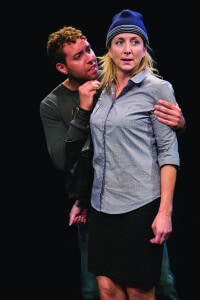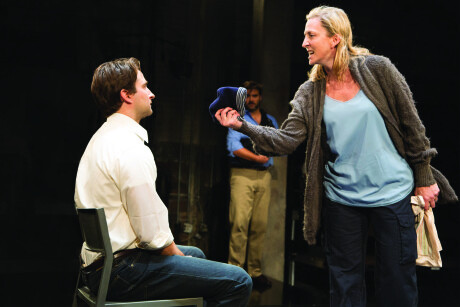After I saw an early Women’s Voices Theater Festival production (I’ve been to 16 and counting), a question lingered in my mind: Exactly what distinguishes a play as being in a woman’s voice other than the fact that the author is female? Well, last night I got an answer that had my mind reeling.

It’s a doozy of a play with a central character, Rachel, whose story could not be other than a woman’s. It’s a play that dramatizes Rachel’s relational and inner life so intuitively and specifically that its author could not be other than someone who has lived a woman’s life. The play is Animal and the author is Clare Lizzimore. And to witness the cracking good Studio X production of Animal now playing at The Studio Theatre is to behold a brilliance of uniqueness and universality that exemplifies why the Women’s Voices Theater Festival exists.
Rachel can be very funny. Lizzimore has given her a mordant wit, a sardonic tongue, and a torrent of zingers that Kate Eastwood Norris tears into with a tenacity that turned gasps to laughs and laughter to gasps. But Rachel is having a massive mental meltdown—an authentic clinical diagnosis as it turns out. (I had not heard of it but I Googled it after; Lizzimore got it spot on.) Rachel can’t sleep, she’s super stressed and hyper, she’s manic then morose, she imagines that unreality is real.
Tom, Rachel’s husband, is for the most part solicitous. He tries to be kind, he tries to let her know he loves her. Cody Nickell plays him with earnestness and sensitivity, and Lizzimore writes their relationship in language that sears:
Rachel: Why are you so nice to me? You’re banging your head against a brick wall here, and you just keep running, and there’s blood, and it’s in your eyes, but still you run, bang, bang, bang—
Tom: Cause I know you’re behind it.
Rachel: What if I’m not?
Rachel’s tormenting symptoms, which from the beginning are more than she can cope with, become more than Tom can handle as well. At his tipping point between restraint and resentment, he blurts out,
You’re a mess. You really really are. You push and push, and I put up with it. But no. Not now.
Rachel’s unflappable shrink is Stephen, and their early scenes set an entertaining tone of sharp repartee laced with dark humor. Responding to his suggestion that she join a support group of others who suffer similarly, she comes back at him with comic/caustic sarcasm:
That’s like putting someone with claustrophobia in a lift and saying it’s okay because there’s this whole other group of people who feel exactly the same; and don’t worry they’ll all be here in a minute.
Joel David Santner playing Stephen is fascinating as he walks the role’s fine line between sympathy-for-hire professional competence and Rachel’s dim view of him as a cartoon.
In the world of the play, which episodically blurs into the world of Rachel’s mind, there are three other characters—a drop-in dude named Dan (whose hornyness Michael Kevin Darnall makes hilarious), a wheelchair-bound invalid Older Woman (whose wordless simpering Rosemary Regan makes ominous), and a Little Girl (whose bluntness Anaïs Killian makes touching with a skill well beyond her middle-school years).

Director Gaye Taylor Upchurch gets each beat, move, and effect precisely right. Set Designer Rachel Hauck has the play happen in a black box within a black box with the audience seated on four sides of a shiny black square stage. It is a perilously polished surface on which we watch Rachel’s mind slip and lose its grip. Together Lighting Designer Jesse Belsky and Sound Designer Daniel Kluger have broken up the play’s succession of scenes with abrupt and unnerving effects that aptly capture the protagonist’s shattered cognition.
And the fact that the protagonist is female is organic to the play. Animal frames the meaning of a woman’s voice about a woman’s life with profound importance and particularity. The image of animality in the title is evoked both textually and subtextually as Lizzimore steadily discloses the play’s secrets. The distinct way those secrets are gendered and grounded in human mammality comes as a mind-blowing reveal. It would be wrong to give away any more than that the ending is a knockout.
Animal plays through October 25, 2015 at The Studio Theatre’s Studio X – 1501 14th Street NW, in Washington, DC. For tickets, call the box office at (202) 332-3300, or purchase them online.
LINK:
The Women’s Voices Theater Festival: ‘Animal’ at The Studio Theatre (Review #2) by Ravelle Brickman on DCMetroTheaterArts.





